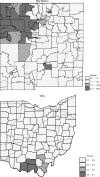Addressing racial and ethnic disparities in health care: using federal data to support local programs to eliminate disparities
- PMID: 16899018
- PMCID: PMC1797089
- DOI: 10.1111/j.1475-6773.2006.00549.x
Addressing racial and ethnic disparities in health care: using federal data to support local programs to eliminate disparities
Abstract
To reduce racial and ethnic disparities in health care, managers, policy makers, and researchers need valid and reliable data on the race and ethnicity of individuals and populations. The federal government is one of the most important sources of such data. In this paper we review the strengths and weaknesses of federal data that pertain to racial and ethnic disparities in health care. We describe recent developments that are likely to influence how these data can be used in the future and discuss how local programs could make use of these data.
Figures
Similar articles
-
Measuring racial/ethnic disparities in health care: methods and practical issues.Health Serv Res. 2012 Jun;47(3 Pt 2):1232-54. doi: 10.1111/j.1475-6773.2012.01387.x. Epub 2012 Feb 21. Health Serv Res. 2012. PMID: 22353147 Free PMC article. Review.
-
Racial-ethnic disparities in stroke care: the American experience: a statement for healthcare professionals from the American Heart Association/American Stroke Association.Stroke. 2011 Jul;42(7):2091-116. doi: 10.1161/STR.0b013e3182213e24. Epub 2011 May 26. Stroke. 2011. PMID: 21617147
-
Person and place: the compounding effects of race/ethnicity and rurality on health.Am J Public Health. 2004 Oct;94(10):1695-703. doi: 10.2105/ajph.94.10.1695. Am J Public Health. 2004. PMID: 15451735 Free PMC article.
-
Pandemic influenza planning in the United States from a health disparities perspective.Emerg Infect Dis. 2008 May;14(5):709-15. doi: 10.3201/eid1405.071301. Emerg Infect Dis. 2008. PMID: 18439350 Free PMC article.
-
Race, Ethnicity, Hypertension, and Heart Disease: JACC Focus Seminar 1/9.J Am Coll Cardiol. 2021 Dec 14;78(24):2460-2470. doi: 10.1016/j.jacc.2021.06.017. J Am Coll Cardiol. 2021. PMID: 34886968 Review.
Cited by
-
Identifying the Transgender Population in the Medicare Program.Transgend Health. 2016 Dec 1;1(1):250-265. doi: 10.1089/trgh.2016.0031. eCollection 2016. Transgend Health. 2016. PMID: 28861539 Free PMC article.
-
Receipt of disease-modifying antirheumatic drugs among patients with rheumatoid arthritis in Medicare managed care plans.JAMA. 2011 Feb 2;305(5):480-6. doi: 10.1001/jama.2011.67. JAMA. 2011. PMID: 21285425 Free PMC article.
-
Racial Disparities in Mortality Among American Film Celebrities: A Wikipedia-Based Retrospective Cohort Study.Interact J Med Res. 2019 Dec 10;8(4):e13871. doi: 10.2196/13871. Interact J Med Res. 2019. PMID: 31821148 Free PMC article.
-
Measuring racial/ethnic disparities in health care: methods and practical issues.Health Serv Res. 2012 Jun;47(3 Pt 2):1232-54. doi: 10.1111/j.1475-6773.2012.01387.x. Epub 2012 Feb 21. Health Serv Res. 2012. PMID: 22353147 Free PMC article. Review.
-
Disparities in public use data availability for race, ethnic, and immigrant groups: national surveys for healthcare disparities research.Med Care. 2010 Dec;48(12):1122-7. doi: 10.1097/MLR.0b013e3181ef984e. Med Care. 2010. PMID: 20966785 Free PMC article.
References
-
- AHRQ (Agency for Healthcare Research and Quality) National Healthcare Disparities Report. 2005. [July 17, 2005]. Available at http://qualitytools.ahrq.gov/disparitiesreport/browse/browse.aspx.
-
- Baicker K, Chandra A, Skinner J S, Wennberg J E. Who You Are and Where You Live: How Race and Geography Affect the Treatment of Medicare Beneficiaries. Health Affairs. 2004 (Suppl Web Exclusive:VAR33-44) - PubMed
-
- Bureau of Primary Health Care. The Uniform Data System Calendar Year 2002 Data. 2004. [July 17, 2005]. Available at http://bphc.hrsa.gov/uds/data.htm.
Publication types
MeSH terms
LinkOut - more resources
Full Text Sources


